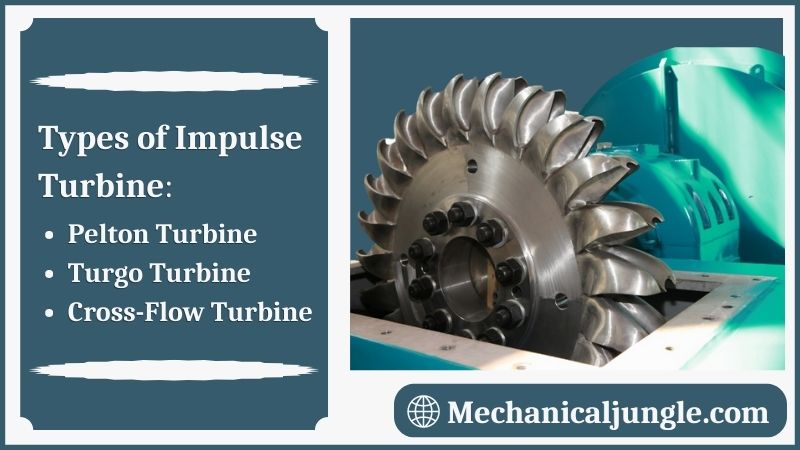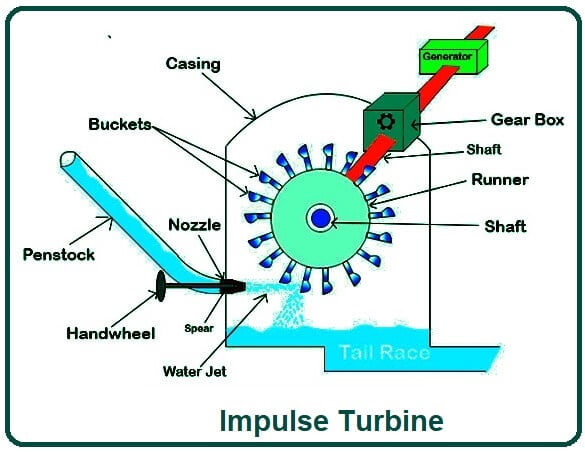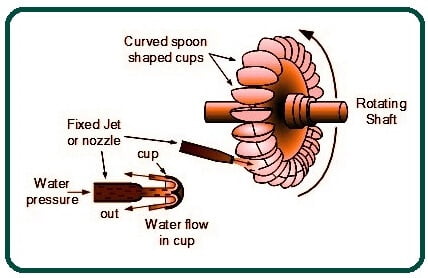Important Point
What Is Impulse Turbine?
Impulse turbines are defined as turbines in which high-velocity sprays of water or condensation impinge on the turbine blades, turning the turbine and generating electrical power. An impulse turbine is so called because this operates on the stimulation power generated by the exceptional dagger of the water jet.
In stimulation turbines, water strikes the cutlass tangentially; therefore, this is correspondingly called a tangential turbine. Impulse turbines are suitable for high chairperson and subordinate water flow. This means that this is utilized when the piece of water is low, and the pressure is heightened due to the elevated position of the water column.
Turbines are predominantly categorized into two categories:
- Impulse turbine
- Reaction Turbine
In these articles, we will discuss the first type, which is an impulse turbine. In impulse turbines, the kinetic energy coming from the nozzles is converted into high-velocity water jet turbine shaft work. The blades of the impulse turbine are usually bucket-shaped.
History:- In 1672, an impulse steam turbine-driven car was designed by Ferdinand Veribest. In 1827 a compound impulse turbine was patented by the Frenchmen Real and Pichon.
Also, Read: Rivets and Types of Riveted Joints | Advantages of Riveted Joints | Disadvantages of Riveted Joints
Impulse Turbine:
The impulse turbine changes the velocities of a water jet. The jet is mounted on the winding blade of the turbine, which changes the direction of flow. A change in stimulation (impulse) generates intimidation on the turbine cutlass. As the turbine is spinning, the force acts through a distance (work), and the oblique water flow is released with less energy.
Before pounding the turbine wheels, the water intimidation potential energy is transformed into kinetic significance by the nozzle, and the turbine is directed. There is no pressure change on the turbine blades, and the turbine is not required for operation.
Newton’s double law expresses the transfers of exuberance to impulse turbines. An impulse turbine is most often used in very high head applications.
Types of Impulse Turbine:
1. Pelton Turbine
Pelton turbine is the most well-known type of impulse turbine. Each bucket used in this type of turbine has double cups with splitters between the cups. The Pelton turbine separates the jet of water between the cups and thus increases the turbine’s performance. Pelton turbines can achieve efficiency up to 95%, and efficiency up to 90% is achievable in micro-level hydroelectric plants.
2. Turgo Turbine
The Turgo turbine is the impulse turbine that is best suited for medium-head operation. The buckets used in turbo turbines have single cups, and the cups are more shallow. Unlike the Pelton turbine, the water jet in the Targo turbine hits the blade once (about 20 degrees). Turgo turbines can be used at very high rotational speeds. They can handle higher flow rates than similar-sized Pelton turbines.
3. Cross-Flow Turbine
Cross-flow turbines are modified forms of impulse turbines mainly used in small hydropower plants. The cross-flow turbine was developed in 1903 by Anthony Michel, Donnet Banki, and Fritz Osberg. They are comfortable with making and requiring exceptionally little supervision. In cross-flow turbines, water passes through the turbine or across the turbine blade, unlike other turbines where water flows axially or radially.
Also, Read: Resistance Projection Welding | Working of Resistance Projection Welding
Components of an Impulse Turbine:
1. Penstock
The penstock impulse is a channel or pipe to deliver water to the turbine. Using this penstock, water is brought to the turbine at the high head. This penstock is associated with water reserves. The water reservoir is typically several meters high.
2. Nozzle
Nozzles are used to increase the kinetic significance of water and stream water on turbine blades. This nozzle constitutes a high-speed jet. This demonstrates the discharge of water in a specific direction to the blade. A stimulation turbine can use one or more nozzles.
3. Runners
The runner is a circular disk mounted on a rotating shaft. This rotating shaft is comprehended as a rotor. On the runner, there are also cup-shaped blades that are evenly rounded. A cup-shaped cutter, correspondingly called a bucket, is ascended on the adventurer. These buckets are established in such a course that these buckets are evenly distributed.
4. Bucket
Buckets are cup or spoon-shaped blades of a turbine. The bucket is positioned around the perimeter of the adventurer so that the pressurized liquid hits the bucket; The bucket is accelerated by the fluid and supports the adventurer to circle with the fluid’s indication.
5. Casing
In the impulse turbine, the container is utilized to prevent the splashing of water and to supervise the flow of water so that the water accomplishes not overflow. This cover is also used to protect components from the external environment. The cover is usually made of cast iron.
6. Braking Jet
The braking jets are used to stop the turbine blades after the water supply is shut off from the nozzle. The turbine cutlasses continue to revolve even behind the nozzle water is blocked due to lassitude. Therefore, the blade is struck from the opposite side of the turbine blade to prevent the blade from rotating immediately.
Also, Read: Parts of Turret Lathe | Working of Turret Lathe | Types of Turret Lathe | Advantages of Turret Lathe
Working Principle of Impulse Turbine:
In this turbine, the stationary intimidation on the wheels is constant, and the turbine wheel is at atmospheric intimidation. The impeller circles in the air, and the blade is disseminated through the nozzle to exchange significance with the turbine. Jet nozzles, or a succession of nozzles, orchestrate the high-velocity stream onto cutlasses, which are usually bucket or cup-shaped. Therefore, only the pressure changes in the nozzle.
The use of curved daggers serves to modify the speed of the flow. This effect generates a change in speed, and, based on the law of energy effects, intimidation is applied to the turbine wheels.
According to Newton’s second law of shifting, the detachments that occur during the movement of the liquid depend on two characteristics: the mass of the liquid penetrating the turbine and the difference in the acceleration of the liquid between the inlet and outlet of the turbine.
Since the mass of the liquid does not change, foremost, the change in speed is accepted into chronology when calculating the strength involved to the explorer.
Thus, the subsequent steps are applied in the process of power generation in impulse turbines.
- The stored water flows upstream from a source through the penstock to reach the nozzle.
- The conceivable energy of water inside the nozzle is transformed into kinetic significance and penetrated into the cutter or bucket; Consequently, the carrier rotates.
- The runner has a mechanism to control the flow of injected water. The spear usually recreates an essential role in this approach.
- A generator attached to the outlet recasts mechanical exuberance into electrical exuberance.
An impulse turbine has the ability to take all kinetic energy from water for high efficiency. When the water reaches the engine, it is released into the conditions from the footing of the turbine accommodation; Therefore, there is no dust at the bottom of the turbine. Here is the working scheme of the impulse turbine, how the kinetic exuberance of the waterworks, as agreeably as the power of its parts.
Also, Read: Chip Thickness Ratio | Shear Angle of Chip Thickness Ratio
Advantages of Impulse Turbine:
Here, the different advantages of impulse turbines are as follows.
- This turbine has heightened efficiency.
- This turbine can function effortlessly at low discharge.
- It is very uncomplicated to assemble.
- This turbine can be accommodated according to the flow rate prerequisite. At high flow accelerations, considerable nozzles are utilized, and at exceptionally low flow accelerations single nozzle is utilized.
Disadvantages of Impulse Turbine:
Here, the different disadvantages of impulse turbines are as follows
- It is very costly to install.
- Its efficiency decreases with time.
- The size of this turbine is large as compared to other types.
- This turbine works only in high heads, which is difficult to control.
Frequently Asked Questions (FAQ)
What Is Impulse Turbine?
The impulse turbine is the simplest type of turbine. It consists of a group of nozzles followed by a row of blades. The gas is expanded in the nozzle, converting the high thermal energy into kinetic energy.
Impulse Turbine
Impulse turbines are defined as turbines in which high-velocity jets of water or steam collide with the blades of the turbine to rotate the turbine and produce electricity using this winding. The impulse turbine is so named because it acts on the impulse force created for the striking blade of the water jet.
Impulse Turbine and Reaction Turbine
The primary distinction between an impulse and a response turbine is that in an impulse turbine, steam passes via the nozzle, but in a reaction turbine, steam passes through the guiding mechanism before passing through the rotating blades.
Impulse Steam Turbine
An impulse turbine is comprised of a stage of stationary nozzles followed by a stage of moving blades. In this turbine, the potential energy of steam is converted into kinetic energy in nozzles.
Working Principle of Impulse Turbine
The runner spins in the air, and the fluid is sprayed to the blades through the nozzle to exchange energy with the turbine. A jet nozzle or a series of nozzles directs the high-speed flow to the blades, which are usually in the shape of buckets or cups.
Advantages of Impulse Turbine
This turbine can work easily at low discharge. It is very easy to assemble. This turbine can be adjusted according to the flow rate condition. At high flow rates, multiple nozzles are used, and at very low flow rates single nozzle is used.
Like this post? Share it with your friends!
Suggested Read –
- Difference Between Orthogonal and Oblique Cutting | Orthogonal Machining
- What Is Magneto Ignition System | How Does an Ignition System Work | How Does a Magneto Work | What Does a Magneto Do | Magneto Ignition System
- What Is a Synchromesh Gearbox? | Principle of Synchromesh Gearbox | Construction of Synchromesh Gearbox | Working of Synchromesh Gearbox
- Working of Constant Mesh Gearbox | What Is a Constant Mesh Gearbox? | Different Gear Ratios in Constant Mesh Gearbox | Construction of Constant Mesh Gearbox
- What Is Cupola Furnace? | Cupola Furnace Design । Cupola Construction | Purpose of Cupola | Working Principle of Cupola Furnace: | Advantages of Cupola Furnace | Disadvantages of Cupola Furnace | Applications of Cupola Furnace




Leave a Reply